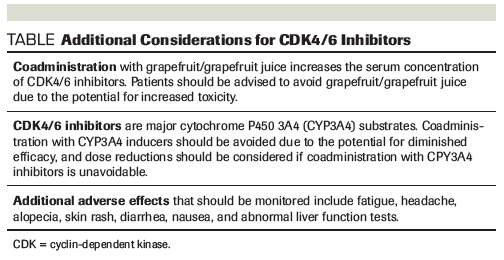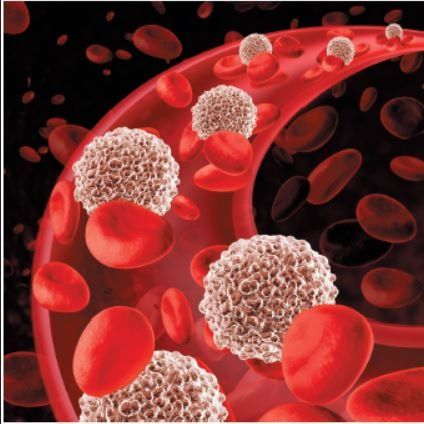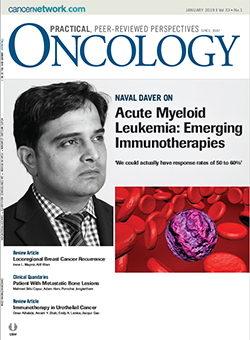Management of Neutropenic Toxicity From CDK4/6 Inhibitors
An oncology pharmacist discusses how to manage neutropenic toxicity from treatment with CDK4/6 inhibitors for HR-positive breast cancer.
Oncology (Williston Park). 33(1):26-7.

Kristina Frinzi Byers, PharmD, BCOP

Table. Additional Considerations for CDK4/6 Inhibitors

Inhibition of the CDK6 pathway leads to senescence of hematologic precursor cells, resulting in the neutropenia associated with CDK4/6 inhibitors. (image courtesy of FreshIdea/Adobe Stock)

Introduction
Cyclin-dependent kinase (CDK) 4/6 inhibitors are a class of anticancer medications that can reduce or eliminate endocrine resistance when used in combination with endocrine therapy for the treatment of hormone receptor–positive (HR+) breast cancer. Currently, three CDK4/6 inhibitors are approved for the initial treatment of HR+ advanced breast cancer in combination with an aromatase inhibitor (AI): abemaciclib,[1] palbociclib,[2] or ribociclib[3]. Additionally, ribociclib can be used in the first-line setting in combination with fulvestrant, and abemaciclib is appropriate as monotherapy for disease progression, following both endocrine therapy and chemotherapy. The addition of CDK4/6 inhibitors to endocrine therapy presents new challenges for providers, particularly regarding laboratory monitoring for neutropenic toxicities.[4]
Association Between CDK4/6 Inhibitors and Neutropenia
In the PALOMA-2 and PALOMA-3 trials, neutropenia was the most common adverse effect reported in patients receiving palbociclib (80% and 83%, respectively), with grade > 3 neutropenia accounting for the majority of cases (66% in both trials). The median time to onset of neutropenia was 15 days with an average duration of 7 days.[5,6] Data compiled from the MONALEESA trials[2,3,7] indicate that neutropenia was the most common adverse effect seen in patients receiving ribociclib (all grade, 74%; grade > 3, 58%). The median time to onset of neutropenia (grade > 2) was 16 days with an average duration of 12 days.[7-9]. The efficacy and safety of abemaciclib was evaluated in the MONARCH trial series. Rates of neutropenia in patients receiving abemaciclib were 41% (22%, grade > 3) in MONARCH-3, 46% (32%, grade > 3) in MONARCH-2, and 37% (27%, grade > 3) in MONARCH-1. Median time to first episode of neutropenia was 29 to 33 days with a duration of 11 to 15 days [10-12]. Despite the higher rates of grade > 3 neutropenia reported in the trials evaluating CDK4/6 inhibitors, the incidence of febrile neutropenia was relatively low (palbociclib, 1.8%; ribociclib, 1%; abemaciclib, < 1%), suggesting CDK4/6 inhibitor–induced neutropenia rarely leads to infection.
Mechanism of Action
Mechanistically, CDKs regulate cell cycle progression from the G1 to the S phase. CDK6 is particularly involved in the differentiation of hematologic precursor cells. Inhibition of this pathway leads to senescence of hematologic precursor cells, resulting in the neutropenia associated with CDK4/6 inhibitors. For palbociclib and ribociclib, cell arrest does not lead to the apoptosis seen with cytotoxic chemotherapy, and intermittent dosing allows for neutrophil recovery. However, abemaciclib has greater selectivity for CDK4 than CDK6, which likely accounts for the lower rates of neutropenia reported in clinical trials. Instead, diarrhea and fatigue are more commonly associated with abemaciclib than palbociclib and ribociclib.[13]
Monitoring Parameters and Dose Modifications
As seen in the clinical trials, onset of neutropenia occurred most commonly in the first 2 weeks of treatment. As a result, strict monitoring is recommended during the first 2 cycles of treatment for all three CDK4/6 inhibitors. For palbociclib and ribociclib, a complete blood count (CBC) with differential should be obtained prior to treatment initiation every 2 weeks for the first 2 cycles, then monthly for the next 4 cycles. If neutropenia remains < grade 2 during the first 6 months, CBC with differential can be extended to once every 3 months at the discretion of the prescriber. For abemaciclib, CBC with differential should also be obtained prior to treatment initiation and every 2 weeks for the first 2 cycles. Due to lower rates of neutropenia seen with abemaciclib, CBC with differential should continue monthly for 2 additional cycles, and then at the discretion of the provider thereafter. No dose adjustments are required for grade < 2 neutropenia (absolute neutrophil count [ANC], 1.0 × 109 /L [lower limit of normal]). Grade 3 neutropenia (ANC range, 0.5–1.0 × 109 /L) requires treatment interruption until neutrophil recovery is < grade 2, with resumption at the same dose level. Recurrent grade 3 neutropenia, grade 3 neutropenia with fever (> 101.3°F), and grade 4 neutropenia (ANC < 0.5 × 109 /L) all require dose interruption until neutrophil recovery is < grade 2, with resumption at the next lower dose level.[1-3].
References:
1. Abemaciclib (Verzenio) prescribing information. http://uspl.lilly.com/verzenio/verzenio.html#pi. Accessed November 16, 2018.
2. Palbociclib (Ibrance) prescribing information. http://labeling.pfizer.com/ShowLabeling.aspx?id=2191. Accessed November 16, 2018.
3. Ribociclib (Kisqali) prescribing information. https://www.pharma.us.novartis.com/sites/www.pharma.us.novartis.com/files/kisqali.pdf. Accessed November 16, 2018.
4. Sammons SL, Topping DL, Blackwell KL. HR+, HER2- advanced breast cancer and CDK4/6 inhibitors: mode of action, clinical activity, and safety profiles. Curr Cancer Drug Targets. 2017;17(7):637-49.
5. Diéras V, Rugo HS, Schnell P, et al. Long-term pooled safety analysis of palbociclib in combination with endocrine therapy for HR+/HER2- advanced breast cancer (PALOMA-2). J Natl Cancer Inst. 2018 Jul 18. [Epub ahead of print]
6. Verma S, Bartlett CH, Schnell P, et al. Palbociclib in combination with fulvestrant in women with hormone receptor-positive/HER2-negative advanced metastatic breast cancer: detailed safety analysis from a multicenter, randomized, placebo-controlled, phase III study (PALOMA-3). Oncologist. 2016;21:1165-75.
7. Hortobagyi GN, Stemmer SM, Burris HA, et al. Ribociclib as first-line therapy for HR-positive, advanced breast cancer. N Engl J Med. 2016;375:1738-48.
8. Slamon DJ, Neven P, Chia S, et al. Phase III randomized study of ribociclib and fulvestrant in hormone receptor-positive, human epidermal growth factor receptor 2-negative advanced breast cancer: MONALEESA-3. J Clin Oncol. 2018;36:2465-75.
9. Tripathy D, Im SA, Colleoni M, et al. Ribociclib plus endocrine therapy for premenopausal women with hormone-receptor-positive, advanced breast cancer (MONALEESA-7): a randomised phase 3 trial. Lancet Oncol. 2018;19:904-15.
10. Dickler MN, Tolaney SM, Rugo HS, et al. MONARCH 1, a phase II study of abemaciclib, a CDK4 and CDK6 inhibitor, as a single agent, in patients with refractory HR+/HER2- metastatic breast cancer. Clin Cancer Res. 2017;23:5218-24.
11. Sledge GW Jr, Toi M, Neven P, et al. MONARCH 2: abemaciclib in combination with fulvestrant in women with HR+/HER2- advanced breast cancer who had progressed while receiving endocrine therapy. J Clin Oncol. 2017;35:2875-84.
12. Goetz MP, Toi M, Campone M, et al. MONARCH 3: abemaciclib as initial therapy for advanced breast cancer. J Clin Oncol. 2017;35:3638-46.
13. Spring LM, Zangardi ML, Moy B, et al. Clinical management of potential toxicities and drug interactions related to cyclin-dependent kinase 4/6 inhibitors in breast cancer: practical considerations and recommendations. Oncologist. 2017;22:1039-48.
